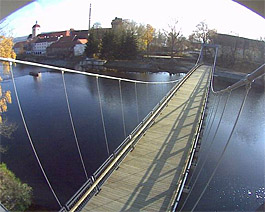
The best new construction of this year is the footbridge in Strakonice
 |
"I am very glad that the jury noticed that architecture is not only made up of houses and buildings, but also bridges. Because we architects struggle with them too," commented the eighth laureate of the traditional heritage award on her victory. In this architectural competition, she left behind the nominated guesthouse at Pálava and the Factory office center building in Prague's Smíchov.
In previous years, a number of architectural works have received the award, including family houses, sacred buildings, and office complexes.
The placement of new buildings into historical development has previously been successfully achieved by the authors of the Portheimka office center or the National Technical Library in Dejvice, Prague 6. "Often buildings, for example in villages, serve as a certain model. However, it is not about competing with the old development. They should complement and enrich," wrote historian and art and architecture theorist Rostislav Švácha regarding this year's results.
"Even a disharmonious element can be part of a harmonious whole. According to the principle of yin and yang, where architects and heritage specialists are these contradictory elements. These are two sides of a single whole - architecture. One creates it and the other protects it," added Kateřina Bečková, chairwoman of the Club for Old Prague.
The Club for Old Prague is a civic association that has been dedicated to the protection of monuments in Prague since its establishment in 1900. New buildings - not only in the Czech capital - have been honored intermittently with annual awards for nearly ten years.
Currently, the club has over 1000 members. At its head is a council composed mainly of art historians, architects, and urban planners. Recently, the club has been focused on the fight to preserve the corner building on Wenceslas Square, which is threatened with demolition.
The English translation is powered by AI tool. Switch to Czech to view the original text source.
0 comments
add comment









